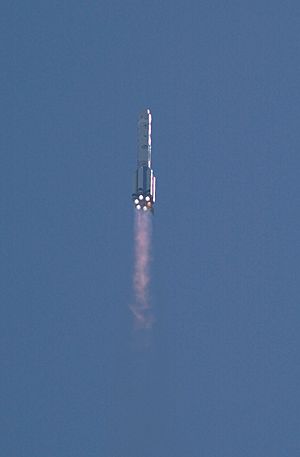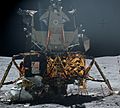Spaceflight facts for kids
Spaceflight is when a thing (spacecraft) made by man flies into outer space. A spaceflight can happen with or without humans on board. The Russian Soyuz program, the US Space Shuttle and the International Space Station are examples of manned (with humans) missions for spaceflight. Space probes and satellites (which orbit the Earth), are examples of unmanned (without humans) spaceflights. These operate either by radio control or are fully independent.
Spaceflight is used for space exploration such as manned missions to the Earth's moon or unmanned missions to other planets in the solar system. Spaceflight can also be used for tourism and satellite telecommunications. A spaceflight begins with a rocket launch, which provides enough energy to get out of Earth's atmosphere and to orbit the Earth. Once the rocket is in space, the activity of the rocket is watched and studied by scientists back on Earth. Some rockets may remain in space forever, some break apart when they reenter Earth's atmosphere. A few land or fall on other planets.
A German V-2 missile crossed the Kármán line (100 km or 62 miles above the Earth) on October 3, 1942. This was the first spaceflight. The first artificial satellite of Earth was the Russian Sputnik 1 on October 4, 1957.
Images for kids
-
Launched in 1959, Luna 1 was the first known artificial object to achieve escape velocity from the Earth. (replica pictured)
-
The MESSENGER spacecraft at Mercury (artist's interpretation)
-
ISS crew member stores samples
-
Astronauts on the ISS in weightless conditions. Michael Foale can be seen exercising in the foreground.
-
This shows an extreme ultraviolet view of the Sun (the Apollo Telescope Mount SO82A Experiment) taken during Skylab 3, with the Earth added for scale. On the right an image of the Sun shows a helium emissions, and there is an image on the left showing emissions from iron. One application for spaceflight is to take observation hindered or made more difficult by being on Earth's surface. Skylab included a massive crewed solar observatory that revolutionized solar science in the early 1970s using the Apollo-based space station in conjunction with crewed spaceflights to it.
See also
 In Spanish: Vuelo espacial para niños
In Spanish: Vuelo espacial para niños













